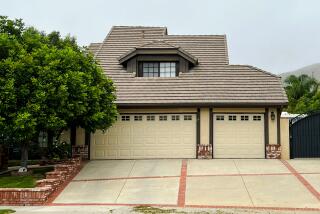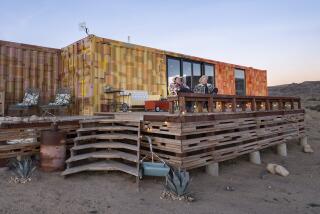
- Share via
SAN DIEGO — The sun-kissed home on Mount Soledad where the late Theodor Geisel gazed at the Pacific and composed most of his beloved series of Dr. Seuss children’s books will soon be put up for sale by its owner, UC San Diego.
The university, which received the property from the Geisel Trust in 2019, told the San Diego Union-Tribune that the 5,000-square-foot home — which doubled as a buzzy hot spot for socialites — will be listed by the end of June.
“The net proceeds from the sale will create the Geisel Fund in the UC San Diego Foundation, which will be an endowment,” the school said in a statement. “Per the wishes of the donor, the chancellor will determine the use of the payout from the endowed fund for campus needs.”
Geisel’s second wife, Audrey, was a strong supporter of UCSD. She donated $20 million to expand the school’s main library in 1995, leading the university to rename the shiny diamond-shaped building Geisel Library.
She died in 2018, having greatly enhanced the financial value of her husband’s writings, which include such classics as “The Cat in the Hat,” “How the Grinch Stole Christmas,” and “Green Eggs and Ham.”
Theodor Geisel, who went by Ted, died in 1991, more than 40 years after he took up residence in his pink stucco, red-tiled roof hideaway on a grubby slope that spills down to the sea.

UCSD did not disclose a listing price for the property, which the locals call the Tower because it includes a building that once served as a perch where real estate agents could show prospective buyers the land below.
The property has four bedrooms and four bathrooms, according to Redfin, a real estate brokerage company, which estimates the property’s value at $5,811,846.
Geisel and his first wife, Helen, decided to make La Jolla their home full time in 1948, when they asked architect Tom Shepard to build “something high up, overlooking everything,” according to Judith and Neil Morgan, authors of “Dr. Seuss & Mr. Geisel: A Biography.”
Shepard led them up to the Tower, which was then an isolated, graffiti-covered hangout for kids.
“All of Southern California seemed in their lap,” the Morgans wrote. “The next morning they bought the tower and two acres around it, eight hundred feet above the center of La Jolla, launching the final step in the dream they had cherished since their first visit [to the area] twenty years earlier.”
Construction soon began on a house that was shaded by eucalyptus trees and oleanders. The couple moved in the following year.
“In this storybook citadel above this fairy-tale mountain, the Geisels lived and worked for the rest of their lives,” the Morgans wrote. Helen died in 1967, and Geisel married Audrey the following year.
Geisel’s career was beginning to flourish, in part because he had a place where he loved to write, paint and create illustrations.
“Here Ted set up his old, ink-streaked desk, with the sloping drafting table in the middle, packed with cans and jars jammed with brushes, pencils, pens, and erasers,” author Brian Jay Jones wrote in his biography, “Becoming Dr. Seuss.”
“Everything was good. ‘I think that La Jolla, at last, will become my basic roosting place,’” Geisel wrote, according to Jones’ biography.
A period of extraordinary success followed, propelled by the sweet, quirky, rhythm and rhyme Geisel used in such books as “The Lorax” (1971) and “Mr. Brown Can Moo! Can You?” (1970).
The Geisels were active socially and regularly opened their home for parties.
It wasn’t particularly easy to get up to the Tower, as the Los Angeles Times made clear in a 1986 feature.
“It is almost easier to get to Dr. Seuss’ mythical land of Solla Sollew than to Geisel’s real-life lair on Mt. Soledad. A narrow road corkscrews up the mountainside; rounding a bend, one almost expects to meet an outrageous figure careening downhill astride a one-wheeler wubble, or at least to spot some of the author’s imaginary menagerie: loraxes, yopps, grinches grouching in grickle-grass, sneetches lurking in lerkims or a covey of green-headed Quilligan quail.”
People who made the trek were rewarded with good food, and lots of silliness.
Claudia Prescott, who was Geisel’s executive secretary and continued as his widow’s executive secretary after he died, recalled a secret hiding place behind a bookcase where the author kept odd-shaped, colorful hats he had collected over the years.
On Thursday nights in the late 1970s and early ’80s, the couple gave small dinner parties for about 10 people about once a month. Guests often included local luminaries such as Helen Copley, Joan Kroc, the Morgans, Jane and Tom Fetter, Walter Munk, various UC San Diego chancellors and others.

Audrey, a gourmet cook, always prepared the meals herself with a little help in the kitchen.
“Sometimes dinner guests put on the hats and acted silly at the dinner parties,” Prescott recalled.
Geisel wrote most of his books in his studio below the upper floor of the Tower, she said.
She explained that the walls were covered in cork board, and Geisel would tack up pages around the room to study and make revisions.
He had a comfortable seating area near his desk where he liked to relax on his days off, Prescott said.
After her husband died, Audrey Geisel supervised a major remodel of the house, but the Tower wasn’t changed.
It remains there today, and will no doubt be a highlight of buyer walk-throughs when the estate goes on sale later this month.
Staff writer Philip Molnar contributed to this report.
More to Read
Sign up for Essential California
The most important California stories and recommendations in your inbox every morning.
You may occasionally receive promotional content from the Los Angeles Times.











